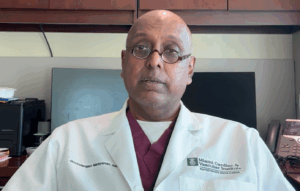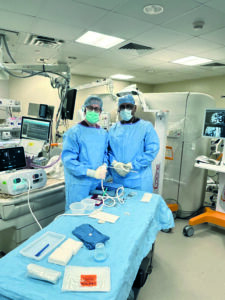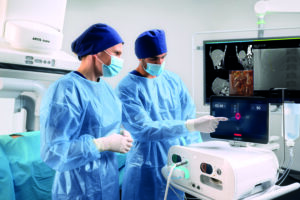This advertorial, sponsored by Varian, is intended only for readers in the USA.

Govindarajan Narayanan (Baptist Health, Miami, USA) recently spoke to Interventional News about the role of microwave ablation and confirmation software in his practice, charting his team’s early impression of their updated set-up.
Narayanan, who is an interventional radiologist and chief of interventional oncology at the Miami Cardiac and Vascular Institute for the Miami Cancer Institute—both of which are part of Baptist Health—has been performing ablations since 2001. During his earlier training, interventionalists commonly used radiofrequency ablation and gradually developed their practice through early iterations of microwave ablation.
In the literature, evidence for the efficacy of microwave ablation has grown, particularly via the recent publication of the COLLISION trial results in the January issue of The Lancet Oncology. The randomised, international, multicentre, phase III non-inferiority trial, led by Martijn Meijerink (Amsterdam UMC, Amsterdam, The Netherlands) et al, demonstrated comparable results between thermal ablation and surgical resection for small-size colorectal liver metastases—initiating re-evaluation of clinical practice and the previously held assumption that ablation should be reserved for unresectable lesions only.
“This study showed that ablation was non-inferior to surgical resection, but more importantly, that they had durability of outcomes and a shorter hospital stay for the patients who underwent ablation. Clearly, this level I evidence is already having an impact. In our practice, we have seen our surgical and medical oncology colleagues embrace these outcomes. This is going to make a huge impact on microwave ablation around the world, providing interventional oncologists with high-level evidence to show that ablation can go toe-to-toe with surgical resection in select patients,” Narayanan said.
For Narayanan, microwave ablation has become an “integral” part of his ablation programme. “It’s the workhorse of all of the ablation procedures that we do,” he commented. Used predominantly in the liver for colorectal liver metastases (CRLMs) and hepatocellular carcinoma (HCC), he added that microwave ablation is “quick, effective, and occupies an important part of helping us manage these patients”.
In early 2024, Narayanan and his team initiated the first robotic ablation programme with confirmation software. The planning and confirmation software “changed the way [his team] looks at ablation confirmation”, Narayanan said.
Narayanan reported that he and his team have observed a positive adjustment in their practice when using planning and confirmation software. “In the past, we would rely on contrast enhancement or lack of enhancement after the ablation procedure, and just try to use measurements to see whether we created an adequate margin,” he stated.
Now, however, Narayanan and colleagues are able to perform a volumetric assessment of the tumour prior to the ablation. Then, following the ablation, they carry out a post-ablation volume measurement and overlay the two images, “which gives us a clearer visual representation of whether our margins were correct, and, if we need to make adjustments, we can do that right away rather than waiting for first follow-up”.

At the end of 2024, Narayanan and his team were one of the first sites to trial the IntelliBlate microwave ablation system. The system, Narayanan described, is compact, reducing its footprint in their department. Using a touchscreen that provides real-time assessments and temperature readings of the ablation zone, his team reports that the system has been easy to implement and use. With the system’s dual-probe functionality, Narayanan is able to place two probes for simultaneous burns, creating a larger ablation zone than what could be achieved with one probe alone. “This is very helpful, it raises the bar, given that we are now expanding ablations to larger tumours,” he stated.
“In many ways, the IntelliBlate system has changed the way we perform ablation, and given the data that have emerged showing the importance of acquiring adequate margins, this change is crucial,” Narayanan added.
“Reliability used to be a problem when performing microwave ablation, as we were not able to predict exactly where the ablation zone might be, but this is a problem of the past with these newer devices. We feel that using confirmation software that provides this information in a reliable fashion right away, will definitely go a long way to producing good outcomes for our patients.”
“In our experience of using different devices, we’ve learned that each has its own nuances and advantages. Some of them also have disadvantages. So, to come up with a device that addresses some of the limitations or problems we’ve experienced with microwave ablation, and has been executed in the way IntelliBlate has, is a welcome addition to the microwave space.”
 Narayanan and his team are currently collecting data on the combination of IntelliBlate with their robotic technology and planning software for microwave ablation. “So far, it has worked very well,” he stated, “but the more patients you treat, the more your experience is enhanced. We believe in collecting data and analysing it. In a few years, we will be able to see the picture this creates for the technology and publish on that,” he continued.
Narayanan and his team are currently collecting data on the combination of IntelliBlate with their robotic technology and planning software for microwave ablation. “So far, it has worked very well,” he stated, “but the more patients you treat, the more your experience is enhanced. We believe in collecting data and analysing it. In a few years, we will be able to see the picture this creates for the technology and publish on that,” he continued.
Of his final conclusions, Narayanan added that through the combination of quality data and more attuned technology, microwave ablation is fast being established as an “important player” in the management of patients with CRLMs. “We’re looking forward to seeing how our data look a year from now,” he said, maintaining that, with experience of the latest advancements in ablation technology, he believes that microwave ablation will continue to be a “mainstay” part of most interventional oncology practices worldwide.










